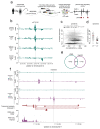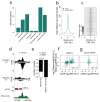High-throughput identification of human SNPs affecting regulatory element activity
- PMID: 31253979
- PMCID: PMC6609452
- DOI: 10.1038/s41588-019-0455-2
High-throughput identification of human SNPs affecting regulatory element activity
Abstract
Most of the millions of SNPs in the human genome are non-coding, and many overlap with putative regulatory elements. Genome-wide association studies (GWAS) have linked many of these SNPs to human traits or to gene expression levels, but rarely with sufficient resolution to identify the causal SNPs. Functional screens based on reporter assays have previously been of insufficient throughput to test the vast space of SNPs for possible effects on regulatory element activity. Here we leveraged the throughput and resolution of the survey of regulatory elements (SuRE) reporter technology to survey the effect of 5.9 million SNPs, including 57% of the known common SNPs, on enhancer and promoter activity. We identified more than 30,000 SNPs that alter the activity of putative regulatory elements, partially in a cell-type-specific manner. Integration of this dataset with GWAS results may help to pinpoint SNPs that underlie human traits.
Conflict of interest statement
J.v.A. is founder of Gen-X B.V. (
Figures






References
Publication types
MeSH terms
Substances
Grants and funding
LinkOut - more resources
Full Text Sources
Other Literature Sources
Molecular Biology Databases
Research Materials

